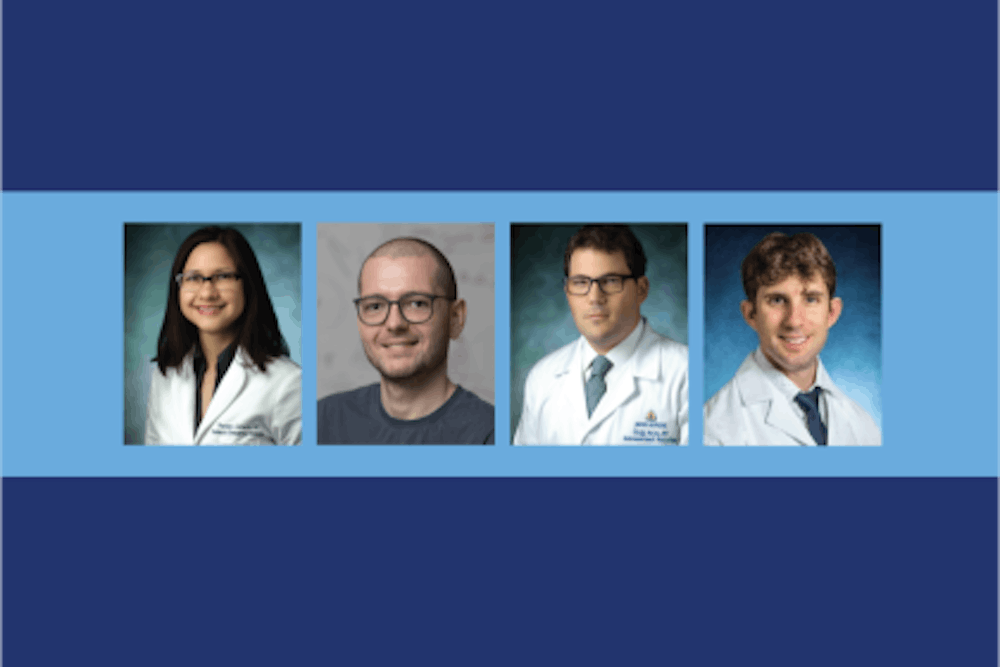The Bisciotti Foundation Translational Fund, which provides funding to Hopkins-affiliated medical groups, was recently awarded to three research teams. Each of these research teams has developed a product intended to solve some problem within the medical field. Ideally, the projects will help increase the accessibility of medical care. According to the Bisciotti Fund’s website, the Bisciotti Fund will aid the teams for up to nine months as they work to commercialize their creations.
Hopkins Hospital Cardiology Fellow Dr. Ethan Tumarkin and Vanderbilt University Cardiology Fellow Dr. David Armstrong developed trans-nasal esophageal echocardiography. Near the beginning of the pandemic, Tumarkin encountered a patient who needed transesophageal echocardiography, or a heart ultrasound performed by inserting an ultrasound probe down the throat, but the patient was not healthy enough to receive it.
Tumarkin talked about the situation in an interview with The News-Letter.
“One of us said, ‘Too bad we can’t find a way to do this without using sedation so we could make it safer.’ So then we started to think about ways to do that, and that’s how the idea developed,” he said.
Their initial idea evolved into trans-nasal esophageal echocardiography, which involves inserting the ultrasound probe through the patient’s nose rather than the throat. They argue that their method of echocardiography is valuable because it expands the availability of heart ultrasounds, since the lack of sedation means the procedure can be carried out anywhere.
“We think that this really could revolutionize the way transesophageal echo[cardiography] is done,” Armstrong said.
Their next step is to start creating prototypes, to which most of their Bisciotti Fund money will be dedicated. They will then use those prototypes to test the product and ensure it follows Food and Drug Administration (FDA) regulations.
Radiology Professor Dr. Clifford Weiss, Radiology Assistant Professor Dr. Christopher Bailey and medical student Aryaman Gupta created a novel gastrojejunostomy feeding tube. They change feeding tubes frequently, and while the procedure is important, it is time consuming and exposes patients to radiation. Bailey and Weiss came up with their idea while brainstorming how to decrease the frequency of tube changes.
This gastrojejunostomy feeding tube is different from normal feeding tubes because it can be replaced by caregivers, while normal tubes can only be replaced by professionals. In an email to The News-Letter, Weiss noted that this way, doctors and patients save time, and the need for anesthesia and fluoroscopic guidance is eliminated.
Like Armstrong and Tumarkin, this team is also planning to use the Bisciotti Fund for prototyping, testing and FDA compliance. Bailey discussed their progress in an interview with The News-Letter, which currently includes patenting and perfecting their technology.
“We’re chipping away at the design phase. The overall concept is solidified, but the individual pieces of that, in order to make it a true, functioning reality — we’re doing a lot of back and forth on that,” Bailey said.
Assistant Professor of Pediatrics Dr. Therese Canares and Assistant Professor in the Department of Computer Science Mathias Unberath designed a novel artificial intelligence-driven strep throat screening system. According to Canares, children with strep throat are commonly taken to the pediatric emergency room (ER) Canares works in, although many cases are not severe enough to justify visiting the ER.
She discussed this further in an interview with The News-Letter.
“Not every strep throat case needs to be seen in the ER. It’s sort of like using a sledgehammer to crack a nut, since the ER is a place you usually go when you’re very, very sick,” she said.
Canares believes that the issue is that many people do not have ready access to other forms of healthcare, so they go to the ER for minor illnesses. Canares had worked with Unberath in the past, so they decided to partner on this project as well. They believe that their technology, an algorithm designed to detect strep throat, will let patients get tested for strep throat without having to come to the ER.
The team plans to use the Bisciotti Fund to develop the app that will house the algorithm and to obtain pictures for training the algorithm, especially since avoiding algorithmic biases is one of Canares and Unberath’s major goals. Additionally, the Fund will help move the project along to the point where Canares and Unberath can obtain more funding.
In the future, they plan to create a startup surrounding the technology. Right now, the planning for that element of the project involves identifying potential customers and talking to experts in the telehealth industry.
In an email to The News-Letter, Canares mentioned that the team is looking for feedback on the project. She encourages anyone who has had tonsillitis or strep throat and is interested in assisting with their technology to email her at therese@jhmi.edu.
All three teams emphasized that receiving the Bisciotti Fund was essential to the advancement of their projects. They all expressed gratitude to both the Bisciotti Fund and external sources of support they believe were crucial in the development of either their technologies or their applications to the Fund.
Armstrong elaborated on this.
“It’s important for us to acknowledge the help we’ve had from the people at Hopkins, both in cardiology and at Hopkins Technology Ventures,” he said. “They really helped us navigate applying for and preparing for the Bisciotti award, and in giving us the confidence and tools we used to succeed.”





